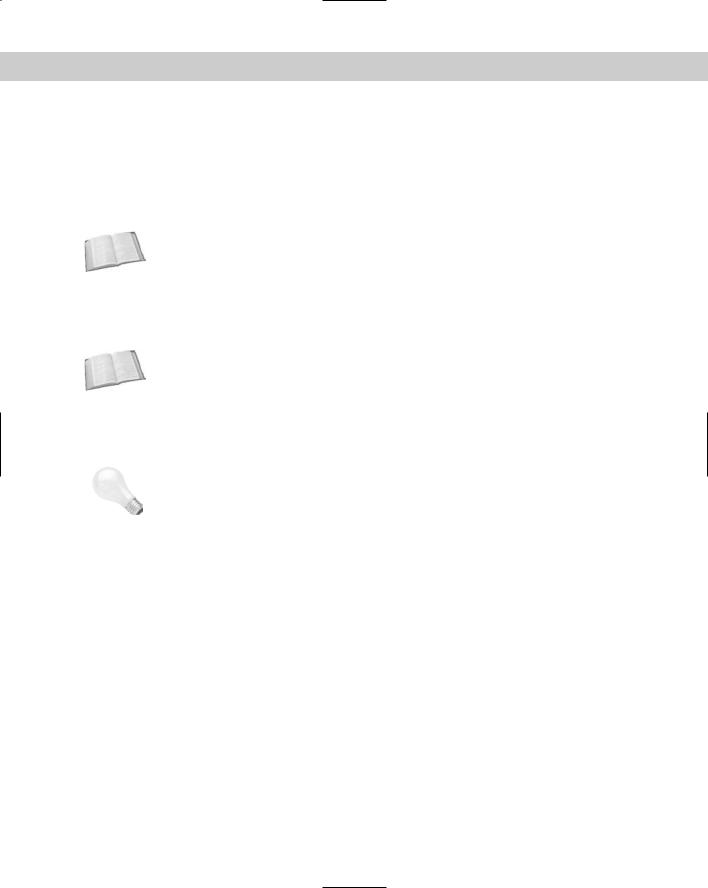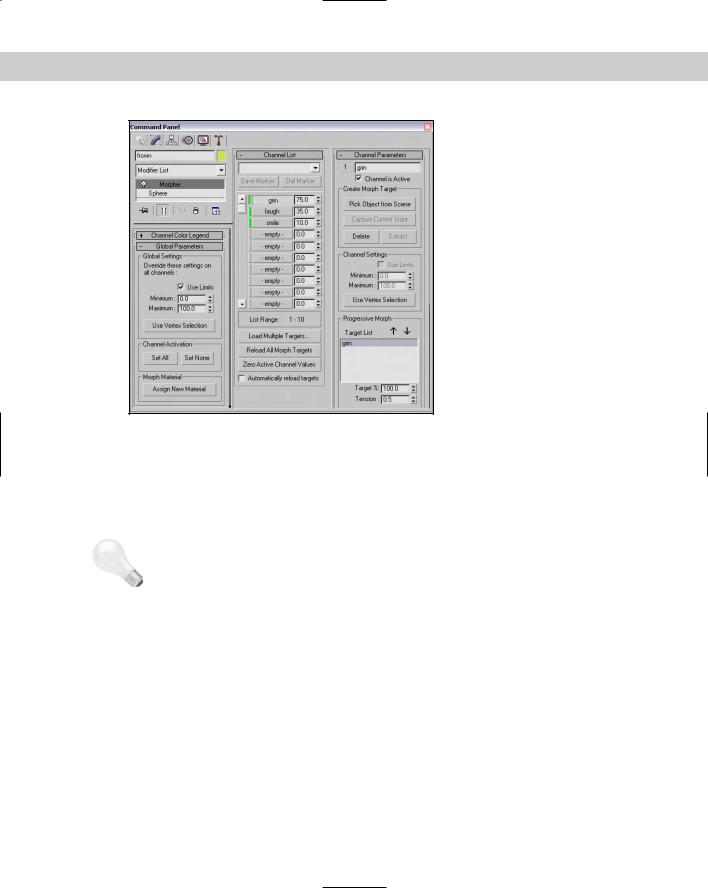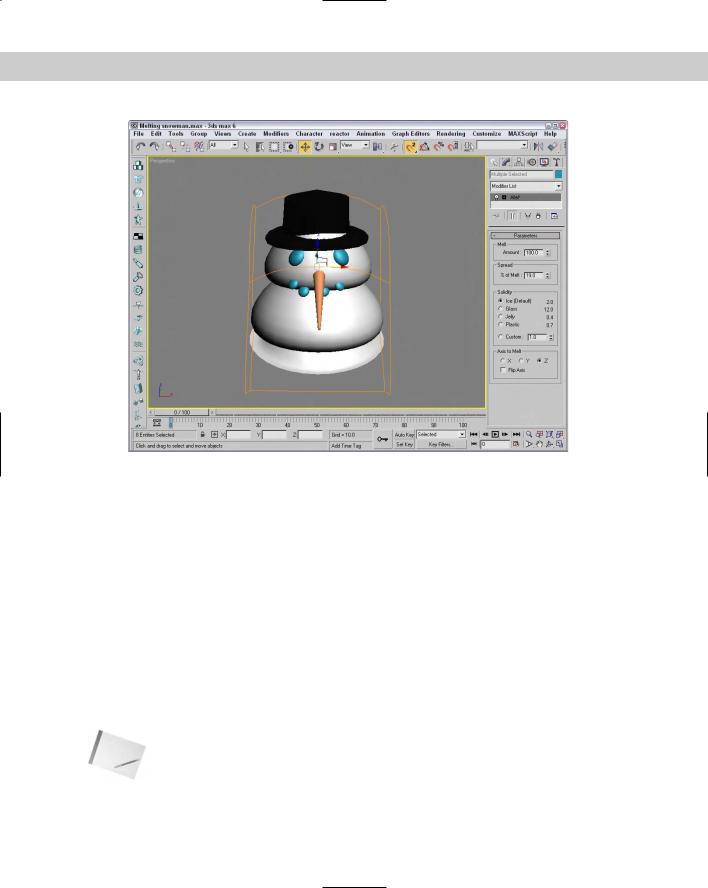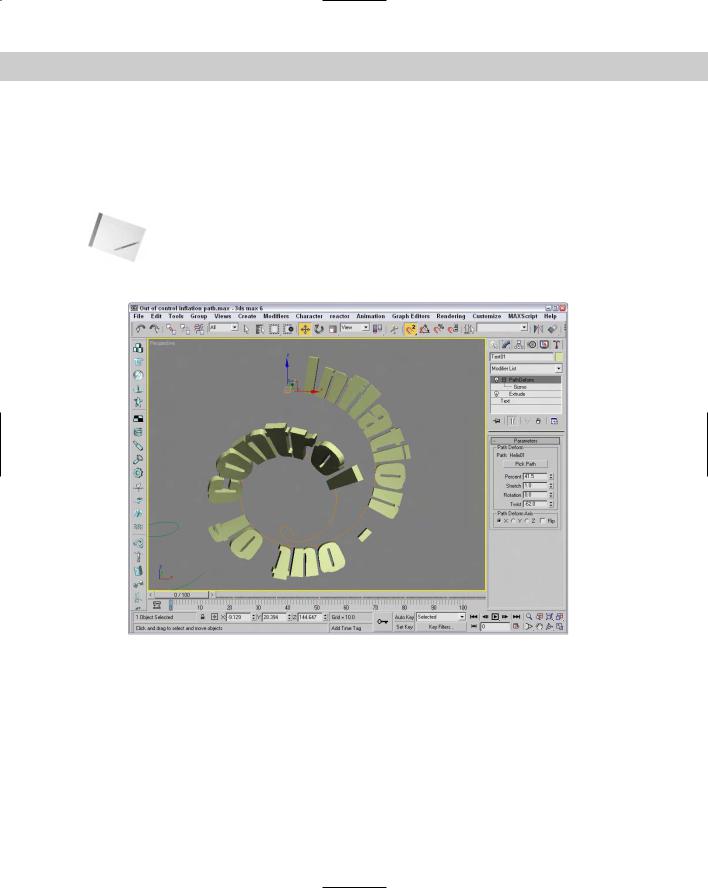
- •Preface
- •About This Book
- •Acknowledgments
- •Contents at a Glance
- •Contents
- •Relaxing at the Beach
- •Dressing the Scene
- •Animating Motion
- •Rendering the Final Animation
- •Summary
- •The Interface Elements
- •Using the Menus
- •Using the Toolbars
- •Using the Viewports
- •Using the Command Panel
- •Using the Lower Interface Bar Controls
- •Interacting with the Interface
- •Getting Help
- •Summary
- •Understanding 3D Space
- •Using the Viewport Navigation Controls
- •Configuring the Viewports
- •Working with Viewport Backgrounds
- •Summary
- •Working with Max Scene Files
- •Setting File Preferences
- •Importing and Exporting
- •Referencing External Objects
- •Using the File Utilities
- •Accessing File Information
- •Summary
- •Customizing Modify and Utility Panel Buttons
- •Working with Custom Interfaces
- •Configuring Paths
- •Selecting System Units
- •Setting Preferences
- •Summary
- •Creating Primitive Objects
- •Exploring the Primitive Object Types
- •Summary
- •Selecting Objects
- •Setting Object Properties
- •Hiding and Freezing Objects
- •Using Layers
- •Summary
- •Cloning Objects
- •Understanding Cloning Options
- •Mirroring Objects
- •Cloning over Time
- •Spacing Cloned Objects
- •Creating Arrays of Objects
- •Summary
- •Working with Groups
- •Building Assemblies
- •Building Links between Objects
- •Displaying Links and Hierarchies
- •Working with Linked Objects
- •Summary
- •Using the Schematic View Window
- •Working with Hierarchies
- •Setting Schematic View Preferences
- •Using List Views
- •Summary
- •Working with the Transformation Tools
- •Using Pivot Points
- •Using the Align Commands
- •Using Grids
- •Using Snap Options
- •Summary
- •Exploring the Modifier Stack
- •Exploring Modifier Types
- •Summary
- •Exploring the Modeling Types
- •Working with Subobjects
- •Modeling Helpers
- •Summary
- •Drawing in 2D
- •Editing Splines
- •Using Spline Modifiers
- •Summary
- •Creating Editable Mesh and Poly Objects
- •Editing Mesh Objects
- •Editing Poly Objects
- •Using Mesh Editing Modifiers
- •Summary
- •Introducing Patch Grids
- •Editing Patches
- •Using Modifiers on Patch Objects
- •Summary
- •Creating NURBS Curves and Surfaces
- •Editing NURBS
- •Working with NURBS
- •Summary
- •Morphing Objects
- •Creating Conform Objects
- •Creating a ShapeMerge Object
- •Creating a Terrain Object
- •Using the Mesher Object
- •Working with BlobMesh Objects
- •Creating a Scatter Object
- •Creating Connect Objects
- •Modeling with Boolean Objects
- •Creating a Loft Object
- •Summary
- •Understanding the Various Particle Systems
- •Creating a Particle System
- •Using the Spray and Snow Particle Systems
- •Using the Super Spray Particle System
- •Using the Blizzard Particle System
- •Using the PArray Particle System
- •Using the PCloud Particle System
- •Using Particle System Maps
- •Controlling Particles with Particle Flow
- •Summary
- •Understanding Material Properties
- •Working with the Material Editor
- •Using the Material/Map Browser
- •Using the Material/Map Navigator
- •Summary
- •Using the Standard Material
- •Using Shading Types
- •Accessing Other Parameters
- •Using External Tools
- •Summary
- •Using Compound Materials
- •Using Raytrace Materials
- •Using the Matte/Shadow Material
- •Using the DirectX 9 Shader
- •Applying Multiple Materials
- •Material Modifiers
- •Summary
- •Understanding Maps
- •Understanding Material Map Types
- •Using the Maps Rollout
- •Using the Map Path Utility
- •Using Map Instances
- •Summary
- •Mapping Modifiers
- •Using the Unwrap UVW modifier
- •Summary
- •Working with Cameras
- •Setting Camera Parameters
- •Summary
- •Using the Camera Tracker Utility
- •Summary
- •Using Multi-Pass Cameras
- •Creating Multi-Pass Camera Effects
- •Summary
- •Understanding the Basics of Lighting
- •Getting to Know the Light Types
- •Creating and Positioning Light Objects
- •Viewing a Scene from a Light
- •Altering Light Parameters
- •Working with Photometric Lights
- •Using the Sunlight and Daylight Systems
- •Using Volume Lights
- •Summary
- •Selecting Advanced Lighting
- •Using Local Advanced Lighting Settings
- •Tutorial: Excluding objects from light tracing
- •Summary
- •Understanding Radiosity
- •Using Local and Global Advanced Lighting Settings
- •Working with Advanced Lighting Materials
- •Using Lighting Analysis
- •Summary
- •Using the Time Controls
- •Working with Keys
- •Using the Track Bar
- •Viewing and Editing Key Values
- •Using the Motion Panel
- •Using Ghosting
- •Animating Objects
- •Working with Previews
- •Wiring Parameters
- •Animation Modifiers
- •Summary
- •Understanding Controller Types
- •Assigning Controllers
- •Setting Default Controllers
- •Examining the Various Controllers
- •Summary
- •Working with Expressions in Spinners
- •Understanding the Expression Controller Interface
- •Understanding Expression Elements
- •Using Expression Controllers
- •Summary
- •Learning the Track View Interface
- •Working with Keys
- •Editing Time
- •Editing Curves
- •Filtering Tracks
- •Working with Controllers
- •Synchronizing to a Sound Track
- •Summary
- •Understanding Your Character
- •Building Bodies
- •Summary
- •Building a Bones System
- •Using the Bone Tools
- •Using the Skin Modifier
- •Summary
- •Creating Characters
- •Working with Characters
- •Using Character Animation Techniques
- •Summary
- •Forward versus Inverse Kinematics
- •Creating an Inverse Kinematics System
- •Using the Various Inverse Kinematics Methods
- •Summary
- •Creating and Binding Space Warps
- •Understanding Space Warp Types
- •Combining Particle Systems with Space Warps
- •Summary
- •Understanding Dynamics
- •Using Dynamic Objects
- •Defining Dynamic Material Properties
- •Using Dynamic Space Warps
- •Using the Dynamics Utility
- •Using the Flex Modifier
- •Summary
- •Using reactor
- •Using reactor Collections
- •Creating reactor Objects
- •Calculating and Previewing a Simulation
- •Constraining Objects
- •reactor Troubleshooting
- •Summary
- •Understanding the Max Renderers
- •Previewing with ActiveShade
- •Render Parameters
- •Rendering Preferences
- •Creating VUE Files
- •Using the Rendered Frame Window
- •Using the RAM Player
- •Reviewing the Render Types
- •Using Command-Line Rendering
- •Creating Panoramic Images
- •Getting Printer Help
- •Creating an Environment
- •Summary
- •Creating Atmospheric Effects
- •Using the Fire Effect
- •Using the Fog Effect
- •Summary
- •Using Render Elements
- •Adding Render Effects
- •Creating Lens Effects
- •Using Other Render Effects
- •Summary
- •Using Raytrace Materials
- •Using a Raytrace Map
- •Enabling mental ray
- •Summary
- •Understanding Network Rendering
- •Network Requirements
- •Setting up a Network Rendering System
- •Starting the Network Rendering System
- •Configuring the Network Manager and Servers
- •Logging Errors
- •Using the Monitor
- •Setting up Batch Rendering
- •Summary
- •Compositing with Photoshop
- •Video Editing with Premiere
- •Video Compositing with After Effects
- •Introducing Combustion
- •Using Other Compositing Solutions
- •Summary
- •Completing Post-Production with the Video Post Interface
- •Working with Sequences
- •Adding and Editing Events
- •Working with Ranges
- •Working with Lens Effects Filters
- •Summary
- •What Is MAXScript?
- •MAXScript Tools
- •Setting MAXScript Preferences
- •Types of Scripts
- •Writing Your Own MAXScripts
- •Learning the Visual MAXScript Editor Interface
- •Laying Out a Rollout
- •Summary
- •Working with Plug-Ins
- •Locating Plug-Ins
- •Summary
- •Low-Res Modeling
- •Using Channels
- •Using Vertex Colors
- •Rendering to a Texture
- •Summary
- •Max and Architecture
- •Using AEC Objects
- •Using Architectural materials
- •Summary
- •Tutorial: Creating Icy Geometry with BlobMesh
- •Tutorial: Using Caustic Photons to Create a Disco Ball
- •Summary
- •mental ray Rendering System
- •Particle Flow
- •reactor 2.0
- •Schematic View
- •BlobMesh
- •Spline and Patch Features
- •Import and Export
- •Shell Modifier
- •Vertex Paint and Channel Info
- •Architectural Primitives and Materials
- •Minor Improvements
- •Choosing an Operating System
- •Hardware Requirements
- •Installing 3ds max 6
- •Authorizing the Software
- •Setting the Display Driver
- •Updating Max
- •Moving Max to Another Computer
- •Using Keyboard Shortcuts
- •Using the Hotkey Map
- •Main Interface Shortcuts
- •Dialog Box Shortcuts
- •Miscellaneous Shortcuts
- •System Requirements
- •Using the CDs with Windows
- •What’s on the CDs
- •Troubleshooting
- •Index

Chapter 30 Animation Basics 759
Animation Modifiers
Modifiers are used to deform and otherwise alter the geometry of objects in an automatic way. These alterations can include animated changes. The Modifiers menu includes a submenu that contains many such modifiers. These modifiers are unique in that each of them changes with time. They can be useful as an alternate to controllers, but their resulting effects are very specific.
Cross- |
To learn more about the Skin modifier, see Chapter 35, “Rigging Characters.” For information |
Reference |
on the Flex modifier, see Chapter 36, “Animating Characters.” |
|
Morpher modifier
The Morpher modifier lets you change a shape from one form into another. You can apply this modifier only to objects with the same number of vertices.
Cross- |
|
In many ways, the Morpher modifier is similar to the Morph compound object, which is cov- |
Reference |
ered in Chapter 17, “Building Compound Objects.” |
|
|
|
|
|
The Morpher modifier can be very useful for creating facial expressions and character lip- |
|
|
synching. You can also use it to morph materials. There are 100 separate channels available |
|
|
for morph targets, and channels can be mixed. You can use the Morpher modifier in con- |
|
|
junction with the Morph material. For example, you could use the Morph material to blush |
|
|
a character for an embarrassed expression. |
|
Tip |
|
When it comes to making facial expressions, a mirror and your own face can be the biggest help. |
|
|
Coworkers may look at you funny, but your facial expressions will benefit from the exercise. |
The first task before using this modifier is to create all the different morph targets. Since the morph targets need to contain the same number of vertices as the base object, make a copy of the base object for each morph target that you are going to create. As you create these targets, be careful not to add or delete any vertices from the object.
After all your morph targets are created, select a channel in the Channel Parameters rollout, shown in Figure 30-21, and use the Pick Object from Scene button to select the morph target for that channel. Another option for picking is to Capture Current State. After a morph target has been added to a channel, you can view it in the Channel List rollout.
As you animate, you can specify the amount of each morph target to include in the frame using the value to the right of the channel name in the Channel List rollout. The slim color bar to the left of the channel name designates the status of the channel. You can find information on what each color represents in the Channel Color Legend rollout.
The Channel Parameters rollout also includes a Progressive Morph section. This feature lets you define an intermediate step for how the morph is to progress with the final step being the morph target. Using these intermediate steps, you can control how the object morphs.

760 Part VII Animation
Figure 30-21: The Morpher modifier’s rollouts
|
Tutorial: Morphing facial expressions |
|
The Morpher modifier is very helpful when you’re trying to morph facial expressions, such as |
|
those to make a character talk. With the various sounds added to the different channels, you |
|
can quickly morph between them. In this example, we use the Morpher modifier to change |
|
the facial expressions of the general character. |
Tip |
When creating facial expressions, be sure to enable the Soft Selection features, which make |
|
modifying the face meshes much easier. |
To change facial expressions using the Morpher modifier, follow these steps:
1.Open the Morphing facial expressions.max file from the Chap 30 directory on the CD-ROM.
This file includes a head model created by Viewpoint Datalabs. The model has been copied twice, and the morph targets have already been created by modifying the subobjects around the mouth.
2.Select the face on the left, and select the Modifiers Animation Modifiers Morpher menu command to apply the Morpher modifier.
3.In the Channel Parameters rollout, select channel 1, click the Pick Object from Scene button, and select the middle face object. Then select the second empty channel from the Channel List rollout; in the Channel Parameters rollout, click again on the Pick Object from Scene button and select the face on the right.

Chapter 30 Animation Basics 761
If you look in the Channel List rollout, you’ll see “cheesy smile” in Channel 1 and “frown” in Channel 2.
4.Click the Auto Key button (or press the N key), drag the Time Slider to frame 50, and then increase the “cheesy smile” channel in the Channel List rollout to 50. Drag the Time Slider to frame 100, and increase the “frown” channel to 100 and the “cheesy smile” channel to 0. Then return the Time Slider to 50, and set the “frown” channel to 0.
5.Click the Play Animation button in the Time Controls to see the resulting animation. Figure 30-22 shows the three facial expressions. The Morpher modifier is applied to the left face.
Tip |
Be sure to keep the morph target objects around. You can hide them in the scene or select |
|
them and save them to a separate file with the File Save Selected menu command. |
Melt modifier
The Melt modifier simulates an object melting by sagging and spreading edges over time. Melt parameters include Amount and Spread values, Solidity (which can be Ice, Glass, Jelly, or Plastic), and a Melt Axis.
Figure 30-23 shows the Melt modifier applied to the snowman model (it was inevitable).
Figure 30-22: Using the Morpher modifier, you can morph one facial expression into another.

762 Part VII Animation
Figure 30-23: The Melt modifier slowly deforms objects to a flat plane.
Linked XForm modifier
The Linked XForm modifier passes all transformations of one object onto another, but not vice versa. The object that controls the transformation is designated as the Control Object and is selected via the Pick Control Object button (which is the only control in the Parameters rollout for this modifier). After the Control object is selected, the Control Object controls the selected object’s transforms, but the object that is being controlled can move independent
of the control object without affecting the control object.
PatchDeform and SurfDeform modifiers
Among the animation modifiers are several modifers that are similar in function, but that work on different types of objects. The PatchDeform modifier uses patches, and the SurfDeform modifier deforms an object according to a NURBS surface.
In the Parameters rollout for each of these modifiers is a Pick Patch (or Surface) button that lets you select an object to use in the deformation process. After the object is selected, you can enter the Percent and Stretch values for the U and V directions, along with a Rotation value.
Note |
The PatchDeform modifier is also available as a World Space Modifier (WSM). WSMs are sim- |
|
ilar to the normal Object Space Modifiers (OSM), except that they use World Space coordi- |
|
nates instead of Object Space coordinates. The most noticeable differences are that WSMs |
|
don’t use gizmos and that the OSM moves the patch to the object, while the WSM causes the |
|
object to move to the patch. |

Chapter 30 Animation Basics 763
Tutorial: Deforming a car going over a hill
Have you seen those commercials that use rubber cars to follow the curvature of the road as they drive? In this tutorial, we use the PatchDeform modifier to bend a car over a hill made from a patch.
To deform a car according to a patch surface, follow these steps:
1.Open the Car bending over a hill.max file from the Chap 30 directory on the CD-ROM.
This file contains a simple hill made from patch objects and a car model created by Viewpoint Datalabs.
2.Select the car model and choose Modifiers Animation Modifiers PatchDeform (WSM). Then click the Pick Patch button in the Parameters rollout and select the hill object.
This applies the World Space PatchDeform modifier (WSM) to the car object and moves the car to align with the hill.
3.Click the Auto Key button (or press the N key) to enable key mode and drag the Time Slider to frame 100. Then set the V Percent value to –50 and click the Auto Key button again to disable key mode.
4.Click the Play button (or press the / key) to see the car deform over the hill.
Figure 30-24 shows the results of this tutorial.
Figure 30-24: Our car model hugs the road, thanks to the PatchDeform modifier.

764 Part VII Animation
PathDeform modifier
The PathDeform modifier uses a spline path to deform an object. The Pick Path button lets you select a spline to use in the deformation process. You can select either an open or closed spline. The Parameters rollout also includes spinners for controlling the Percent, Stretch, Rotation, and Twist of the object. The Percent value is the distance the object moves along the path.
Note If you use the PathDeform modifier, you can benefit from also using the Follow/Bank utility, which gives you control over how the object follows and banks along the path.
Figure 30-25 shows some text wrapped around a spline path.
Figure 30-25: The text in this example has been deformed around a spline path using the PathDeform modifier.
